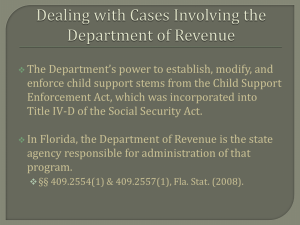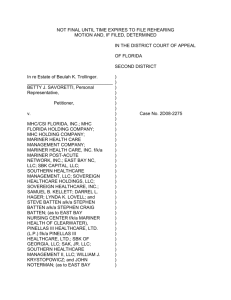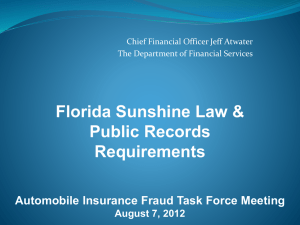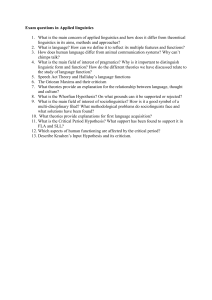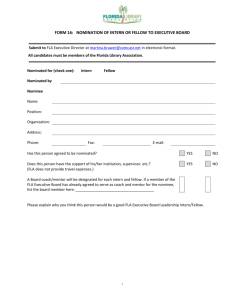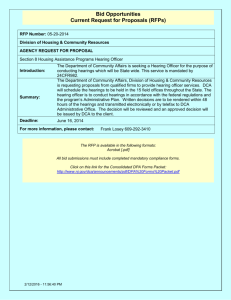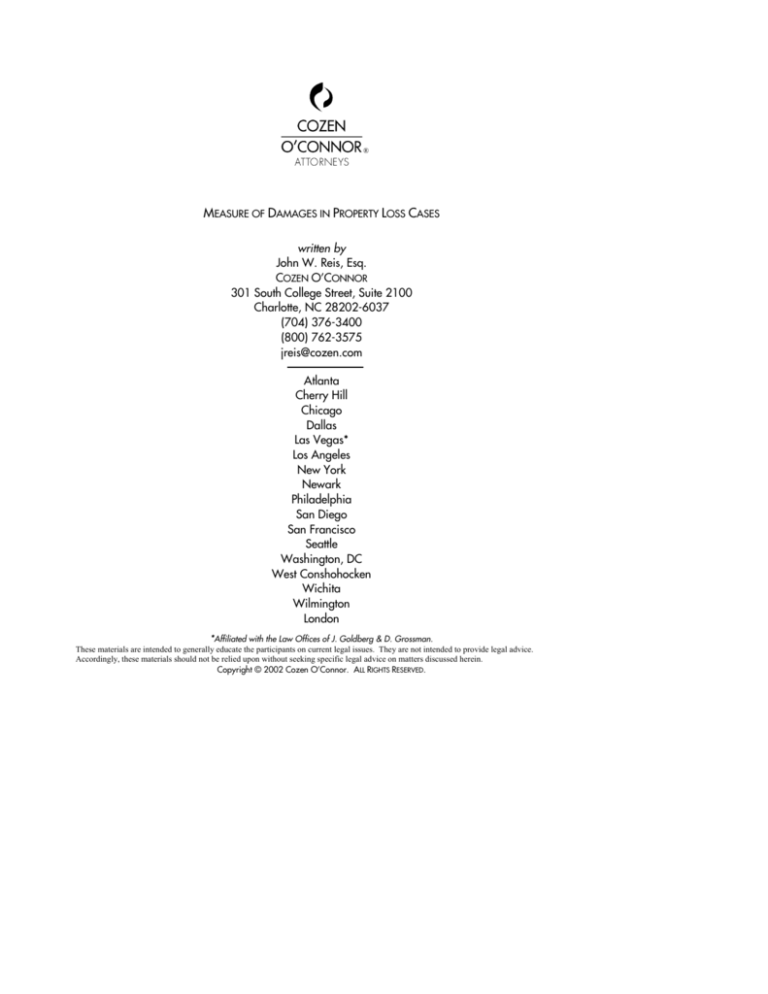
®
MEASURE OF DAMAGES IN PROPERTY LOSS CASES
written by
John W. Reis, Esq.
COZEN O’CONNOR
301 South College Street, Suite 2100
Charlotte, NC 28202-6037
(704) 376-3400
(800) 762-3575
jreis@cozen.com
Atlanta
Cherry Hill
Chicago
Dallas
Las Vegas*
Los Angeles
New York
Newark
Philadelphia
San Diego
San Francisco
Seattle
Washington, DC
West Conshohocken
Wichita
Wilmington
London
*Affiliated with the Law Offices of J. Goldberg & D. Grossman.
These materials are intended to generally educate the participants on current legal issues. They are not intended to provide legal advice.
Accordingly, these materials should not be relied upon without seeking specific legal advice on matters discussed herein.
Copyright © 2002 Cozen O’Connor. ALL RIGHTS RESERVED.
Measure of Damages in Property Loss Cases
By John W. Reis
Proving damages in a large property loss case is often tedious, sometimes complex, and
occasionally treacherous. The drudgery of itemizing the damages is difficult enough. The battle
over entitlement to economic damages is no less daunting. Once entitlement is established, the
weary litigant may have little time or energy left to fully analyze the proper legal standards for
recovering those damages. This article is intended as a survival manual of sorts -- a guide
through the law on the proper measure of property damages in Florida.1
The General Rule of Recovery
For both real and personal property losses, the general rule of recovery is that a property
owner can recover the cost of replacement, repair, or restoration of property, unless the damage
is permanent and the restoration cost will exceed the diminution in the fair market value of the
property, in which case the damages are limited to the diminution in fair market value.2 More
succinctly stated, an award of damages to property is generally limited to the restoration cost or
the diminution in fair market value, whichever is less.3 Thus, for example, in United States Steel
Corporation v. Benefield, 352 So.2d 892, 894-95 (Fla. 2d DCA 1977), cert. denied, 364 So.2d
881 (Fla.1978), the court held that the plaintiff, a property owner, could not recover the full cost
of restoring 26 damaged acres of land but was instead limited to the diminution in value, where
the restoration cost was $13,084 but the property’s entire value was only $12,116 ($466 per
acre).
Establishing “Fair Market Value”
The term “fair market value” is defined as “the amount of money which a purchaser
willing but not obliged to buy the property would pay to an owner willing but not obliged to sell
2
it, taking into consideration all uses to which the property is adapted and might in reason be
applied.”4 Three well-recognized guides to appraisal have evolved, all of which take the
property’s pre-loss physical depreciation into account: “(1) the cost approach; (2) the comparable
sales approach; and (3) the income or economic approach.”5
In the appraisal and insurance industries, the term “actual cash value” is often used to
describe the pre-loss value of certain property, such as vehicles or appliances or structures.
Appraisal guides, such as the Kelley Blue Book6 for vehicles or the Marshall & Swift guide7 on
structures, can help estimate the actual cash value. Although no published Florida case has
directly addressed the use of these insurance appraisal guides to determine diminution in market
value, language from one Florida case indicates that the term “actual cash value” is “generally
synonymous” with fair market value.
In American Reliance Insurance Company v. Perez, 689 So.2d 290 (Fla. 3d DCA 1997),
home owners brought a class action against their property insurer on the meaning of the term
“actual cash value.” In determining that the term was not ambiguous, the court essentially
equated “actual cash value” with “fair market value,” stating as follows:
The insurer contends that the policy language is unambiguous – that when an
insured elects not to repair or replace damage to the insured building, then the
insured is entitled to be paid only the “actual cash value,” i.e., an amount less a
deduction for prior depreciation, because the damaged portion, not being new, had
suffered actual physical depreciation before the hurricane damage. … We find
that the controlling language is not ambiguous. The expression “actual cash
value” is an often-used appraisal term, generally synonymous with “market
value” or “fair market value.”8
“Stigma” Damages
Damaged property sometimes carries a “stigma” associated with the event that
caused the damage even after repairs have been made, especially in cases involving
numerous construction defects, mold damage, or termite infestation. The owner of such
3
property will often desire not only the repair costs, but also the additional diminution in
value associated with the stigma.
In Orkin Exterminating Company, Inc. v. DelGuidice, 790 So. 2d 1058 (5th DCA
2001), for example, the homeowners sought, and the jury awarded, $300,000 against a
pest control company for the lost market value associated with the stigma of repeated
termite infestations. The Fifth District reversed the award based on a provision in the
parties’ contract which limited the homeowners’ remedy to re-treatment and repair of the
damage, but went on to note that stigma/diminution damages would otherwise have been
recoverable under the following circumstances:
[T]he diminution in value damages of $300,000 could have properly been
presented to the jury if competent substantial evidence had been presented that the
cost to repair existing termite damage and the cost of providing effective termite
eradication procedures would have constituted economic waste. In other words,
had evidence been presented that the cost of repair was substantially greater than
the diminution in value, diminution in value would have been the proper standard
to apply.9
Under this holding, stigma damages are recoverable in Florida as an element of
the diminution in market value when reparation is either impracticable or exceeds the
overall diminution in value; however, such damages are not recoverable in addition to the
repair cost when the diminution in value exceeds the repair cost.10
Proof Through a “Qualified” Witness
Courts require that proof of lost fair market value be established by competent,
substantial evidence through a “qualified” witness.11 Generally, the use of expert testimony is
preferred.12 However, most courts will allow a non-expert owner to testify to the value of his or
her own property.13 The rule is “based on the owner's presumed familiarity with the
4
characteristics of the property, his knowledge or acquaintance with its uses and purposes, and his
experience in dealing with it.”14
Burden to Establish the Lesser Figure
Because the owner is generally limited to the lesser of the restoration cost or the
diminution in value, one issue which occasionally arises at trial is whether the owner has the
burden to introduce both figures in order to establish which one is the lowest. One Florida case
holds that an owner seeking repair costs need not prove that repair costs exceeded diminution in
market value,15 but another case holds that an owner seeking the diminution in value must show
that repairs were either impracticable or in excess of the diminution in value.16 Close analysis of
the two cases highlights the distinction.
In American Equity Insurance Co. v. Van Ginhoven, 788 So. 2d 388 (Fla. 5th DCA
2001), plaintiff introduced evidence of, and was awarded at trial, a restoration cost of $48,144.50
for damages to a swimming pool caused by a contractor. On appeal, defendant argued that the
damages should have been limited to the difference between the value of the land before and
after the damages occurred. In its opinion, the court allowed the award to stand, noting that
neither party introduced evidence to establish that the $48,144.50 was higher than the diminution
in value:
In the instant case, Fernandez proved that the costs associated with replacing the
pool and repairing the damages less significant upgrades, was $48,144.50. The
record fails to demonstrate that this cost exceeded the value of the pool in its
original condition or its depreciation in value. Moreover, Fernandez
demonstrated that replacing and repairing the damage was practicable by actually
having it done. Accordingly, American Equity has failed to demonstrate on
appeal that the trial judge erred in awarding Fernandez the cost associated with
replacing her pool and repairing the other damaged property.17
Conversely, in Orkin Exterminating Company, Inc. v. DelGuidice, 790 So. 2d
1058 (5th DCA 2001), the plaintiff introduced evidence of diminution in value caused to a
5
house infested with termites but failed to establish that restoration would be either
impracticable or in excess of the diminution in value. The court reversed the award and
limited the remedy to the contract’s exclusive remedy of repair, but also stated that it
would have affirmed the diminution award if the plaintiff had shown the remedy of repair
to be impracticable or “wasteful,” i.e., in excess of the diminution value. The distinction
between the two cases is that the plaintiff in Van Ginhoven established the practicability
of restoration by actually performing it, whereas the plaintiff in DelGuidice apparently
abandoned the repair efforts and introduced no evidence that restoration was practicable.
The cautious practicioner should thus establish the practicability of restoration
when seeking restoration costs or the impracticability/wastefulness of restoration when
seeking diminution in value, leaving it to the opposing party to show that the alternative
remedy is practicable, quantifiable, and lower.18
Going Beyond the Lesser Figure
Limitation to the lesser of the restoration cost or the diminution in value of an
item of property does not necessarily prevent a party from introducing the higher figure
into evidence. For example, the replacement cost of damaged property can be introduced
as relevant evidence on the question of the diminution in value, or vice versa, in order to
assist the jury in determining the degree of injury to the property.19 In addition, courts
have allowed recovery for loss of use, code upgrades, debris removal, waste remediation,
personal or sentimental value, and extra value for unique service structures.
Loss of Use: Personal Property
6
In the personal property context, an owner is entitled to recover not only for repairs but
also for the loss of use of property, so long as the loss is not total and the owner actually opts to
repair.20 The rule derives from the Restatement of Torts § 928 (1939), which provides:
Where a person is entitled to a judgment for harm to chattels not amounting to a
total destruction in value, the damages include compensation for
(a) the difference between the value of the chattel before the harm and the value
after the harm, or at the plaintiff's election, the reasonable cost of repairs or
restoration where feasible, with due allowance for any difference between the
original value and the value after repairs, and
(b) the loss of use.
This provision was construed in Badillo v. Hill, 570 So.2d 1067, 1068 (Fla. 5th
DCA 1990) as entitling the plaintiff in that case to make an election as to the theory of
recovery, but preventing plaintiff from obtaining “a combination of cost of repairs plus
lessened value before repairs, because that would permit a double recovery.”21
Loss of Use/Living Expenses: Real Property
In the real property context, most jurisdictions follow the same rule as with personal
property, allowing loss of use of realty if the damage caused the owner to be unable to use the
property for a period of time.22
Code Upgrades
Property owners, faced with repairing or replacing property, may be required to comply
with a regulation or code either newly enacted or from which the owner was previously exempt
before the loss. Although no published Florida decision appears to have squarely addressed the
issue in the tort or breach of contract context,23 other jurisdictions have allowed the additional
cost of code compliance.24 Rationales for allowing such recovery include incentive to avoid
cutting corners in the reconstruction and weighing the interests of public safety and the owner’s
full use of the property against the tortfeasor who caused the damage.
7
Debris Removal
Structural damages often involve removal of debris before rebuilding can begin. If the
costs of debris removal is included within the overall rebuilding cost and if that total cost is less
than the diminution in value, it follows that the cost is recoverable. However, in cases where the
debris removal cost causes the restoration cost to exceed the diminution in market value or when
a destroyed structure is not rebuilt but debris removal costs are nonetheless incurred, the question
becomes whether the cost to remove debris from the land is recoverable in addition to the
diminution in market value of the structure. Although no Florida cases provide a direct answer,
this author argues that the cost of removing structural debris from the land should be allowed in
either situation. The structure and land are separate items of property. Debris damages the land,
not the structure. Debris removal restores the land, not the structure, especially where the
structure is not rebuilt. Rebuilding of the structure does not commence until the old structural
debris is removed. In addition, the land’s diminution in value will be directly affected by the
need to remove the debris. Accordingly, the debris removal cost should be recoverable as an
element of the land damage separate and apart from the damage to the structure.
In rare instances, the debris will not have been removed by the time of trial. Nonetheless,
the presence of debris will likely affect the value of the property to a potential purchaser, as with
stigma damages discussed above in DelGuidice. Applying the DelGuidice rationale, the
presence of debris should be a factor in determining the diminution of value even when the
debris has not actually been removed.
Waste Remediation
In cases of damage to land caused by pollution or waste, public policy would seem to
weigh in favor of allowing the owner the full cost to remediate the land in excess of diminution
8
in value as an incentive to remove the hazards posed by such waste. Early cases on the issue,
however, were reluctant to allow such full remediation if the cost exceeded diminution in value.
For example, in both Standard Oil Co. v. Dunagan, 171 So.2d 622 (Fla. 3d DCA 1965) and
Crown Cork & Seal Co. v. Vroom, 480 So.2d 108 (Fla. 2d DCA 1985), landowners who sought
restoration costs for contamination of their groundwater were limited to the diminution in value.
More recently, the Florida Supreme Court distinguished those cases in Davey Compressor
Company v. City of Delray Beach, 639 So.2d 595 (Fla. 1994). There, the court awarded the City
of Delray Beach the full cost of restoration of land polluted by the defendant. While not
expressly receding from Dunagan and Vroom, the decision in Davey Compressor Company gave
increased emphasis on the public policy of full remediation where the contamination adversely
affects the public:
Recognizing the environmental dangers that are directly associated with the
negligent contamination of groundwater, we find that public policy supports
restoration costs as the measure of damages in this case.25
Thus, entitlement to full remediation costs above diminution in value may be
recoverable if the land poses a public health hazard.
Personal, Peculiar, or Sentimental Value
Certain property will possess a special value to the owner that is difficult to quantify in
terms of market value. For example, family heirlooms, photographs, or other irreplaceable items
are often imbued with tremendous sentimental value, but little objective market value. When
such items are destroyed, the owner naturally desires compensation above the fair market value.
Most jurisdictions will allow recovery above the objective diminution in market value for such
items in certain circumstances.26 Florida follows that trend.
9
In Carye v. Boca Raton Hotel and Club Limited Partnership, 676 So. 2d 1020 (Fla. 4th
DCA 1996), the plaintiff, who lost jewelry acquired over a lifetime, sought entitlement to the
sentimental value of the lost items. The Fourth District began by recognizing the right to
recover for lost sentimental value in special circumstances, such as where the item has no market
value or where limitation to the fair market value would be “manifestly unfair”:
It is often impossible to place what is a current market value on such articles but
the law does not contemplate that this be done with mathematical exactness. The
law guarantees every person a remedy when he has been wronged. If the damage
is to personal property as in this case, it may be impossible to show that all of it
had a market value. In fact it may be very valuable so far as the owner is
concerned but have no value so far as the public is concerned. It would be
manifestly unfair to apply the test of market value in such cases.27
The court then noted that the jewelry in question “obviously possessed sentimental value,
as it was accumulated over forty-eight years of marriage and included engagement rings,
wedding bands and anniversary presents.”28 However, because the jewelry “also had significant
market value” -- $156,470 to be precise – and because limitation to that value was not
“manifestly unfair,” the court held that it was improper for the court to have allowed testimony
regarding its sentimental value:
[W]e conclude that in a situation where the lost property has both a market value
and sentimental value, as is the case here, the burden again rests with the plaintiff
to prove that the market valuation would be manifestly unfair.29
Under the Carye approach, a jury may consider the sentimental value of a lost item so
long as plaintiff proves that (1) the item had sentimental value and (2) either (a) the item had no
quantifiable market value or (b) limitation to the market value “would be manifestly unfair.”
Unique Structures
Related to the issue of sentimental value is the issue of entitlement to damages beyond
market value for unique service-type structures belonging to religious groups, hospitals, country
10
clubs, schools, colleges, charitable societies, and similar organizations. Although this author has
uncovered no Florida cases directly addressing the issue, courts from other jurisdictions have
recognized that diminution in fair market value may not adequately quantify the actual loss for
such unique structures.30 The principles announced in Carye, allowing damages beyond market
value upon proof that such limitation would be “manifestly unfair,” can be applied by analogy to
such structures.
Goods for Sale
In the business context, the general rule is that the proper measure of damages for goods
held for sale is not the retail selling price but is limited to wholesale cost of the goods at the time
of the loss.31
[T]he owner of a stock of goods held for sale, which has been damaged or
destroyed, is entitled to recover, as damages, the reasonable cost of replacing such
goods, which includes the wholesale cost at the time of the loss, plus any other
reasonable expenses incurred in the replacement.32
The proper market for determining the market value of such goods is the wholesale
market to which the injured party would have to go to in order to replace the goods.33
Conclusion
The road to recovery in substantial property loss cases can be twisted, dark, and scary.
The practicioner cannot simply rely on the general rule limiting recovery to the lesser of either
the restoration cost or the diminution in value, without also understanding the nuances of the
issues covered in this article. The applicable law on these issues should be read thoroughly and,
in many cases, will need to be applied by analogy in the absence of cases directly on point. As
with any rough terrain, it should be traveled carefully, cautiously, and with as many guides as
possible.
11
John W. Reis is a member of the firm of Cozen O’Connor. He received his A.B. from Duke
University in 1988 and his J.D., cum laude, from the University of Miami School of Law in
1992. He regularly litigates large property loss cases throughout Florida and other Southeastern
states.
PHILA1\1710788\1 099995.000
1
This article also draws from analogous case law in other Southeastern states, including Georgia,
South Carolina, North Carolina, Virginia, Kentucky, Tennessee, Alabama, and Mississippi.
2
United States Steel Corporation v. Benefield, 352 So.2d 892 (Fla. 2d DCA 1977), cert. denied,
364 So.2d 881 (Fla.1978); American Equity Insurance Co. v. Van Ginhoven, 788 So. 2d 388,
391 (Fla. 5th DCA 2001); Bisque Associates of Florida, Inc. v. Power of Quayside No. II
Condominium Association, 639 So. 2d 997 (Fla. 3d DCA 1994); Keyes Co. v. Shea, 372 So.2d
493 (Fla. 4th DCA 1979); Airtech Service, Inc. v. MacDonald Construction Company, 150 So.2d
465 (Fla. 3d DCA 1963). Cf. Fuller v. Martin, 125 So.2d 4 (Ala. 1960);; Ryland Group v. Daley,
537 S.E.2d 732, 738 (Ga. Ct. App. 2000); Ray v. Strawsma, 359 S.E.2d 376 (Ga. Ct. App. 1987);
Island Creek Coal Company v. Rodgers, 644 S.W.2d 339 (Ky. 1982); System Fuels, Inc. v.
Barnes, 363 So.2d 747 (Miss. 1978)(Measure of damages for permanent injury to land is
diminution in value; but where the property can be restored to its former condition at a cost less
than the value determined by the diminution of the value of the land, the measure of damages is
the cost of restoration of the property plus compensation for the loss of its use.); Huberth v.
Holly, 462 S.E.2d 239 (NC Ct. App. 1995) (“[T]he general rule is that where the injury is
completed (as opposed to a continuing wrong) the measure of damages ‘is the difference
between the market value of the property before and after the injury.’ Huff v. Thornton, 23
N.C.App. 388, 393-94, 209 S.E.2d 401, 405 (1974)”); Scott v. Fort Roofing and Sheet Metal
Works, Inc., 299 S.C. 449, 385 S.E.2d 826 (1989) (“Cost of repair or restoration is a valid
measure of damages for injury to a building although compensation may be limited to the value
of the building before the damage was inflicted.”); Redbud Coop. Corp. v. Clayton, 700 S.W.2d
551, 560-61 (Tenn. Ct. App. 1985) (“Our appellate courts have uniformly held that the measure
of damages for injury to real estate is the difference between the reasonable market value of the
premises immediately prior to and immediately after injury but if the reasonable cost of repairing
the injury is less than the depreciation in value, the cost of repair is the lawful measure of
damages.”); Chambers v. Spruce Lighting Co., 95 S.E. 192 (W.V. 1918).
3
Courtney Enterprises, Inc. v. Publix Supermarkets, Inc., 788 So. 2d 1045 (Fla. 2d DCA 2001).
4
American Reliance Insurance Company v. Perez, 689 So.2d 290 (Fla. 3d DCA 1997) (quoting
City of Tampa v. Colgan, 121 Fla. 218, 230, 163 So. 577, 582 (1935) and citing 4 Nichols on
Eminent Domain § 12.02[1], at 12-62 to 12-70 (rev. 3d ed. 1996)). See also Ocean Electric
Company v. Hughes Laboratories, Inc., 636 So. 2d 112 (Fla. 3d DCA 1994) (fair market value
looks at “the price which would be agreed upon at a voluntary sale between a willing seller and a
willing purchaser.”); Charles T. McCormick, Damages § 44 (1935) (market value defined as sale
by leisurely seller to willing buyer).
5
American Reliance Insurance Company v. Perez, 689 So.2d 290 (Fla. 3d DCA 1997) (citing
McNayr v. Claughton, 198 So. 2d 366, 368 (Fla. 3d DCA 1967).
12
Comment [C&O1]: This comment
precedes a field that may contains the
codes for the End of Document ID. DO
NOT insert any text after this
comment!
6
See, e.g., Kelley, Blue Book Used Car Guide: Private Party, Trade-in, Retail Values, 1987-2001
Used Car and Truck, July-Dec. 2002 (May 2002).
7
See, e.g., Marshall & Swift, Residential Cost Handbook (2002).
8
689 So. 2d at 291.
9
790 So. 2d at 1160.
10
Similarly, in Ryland Group v. Daley, 537 S.E.2d 732, 739 (Ga. Ct. App. 2000), the jury
awarded homeowners the cost to repair a house plus “stigma” damages associated with the
home’s history of construction defects. The trial court, however, subtracted the stigma damages,
limiting the award to the reparation costs. On appeal, the appellate court affirmed the reduction,
noting that stigma damages are not to be added to the cost to repair, though such damages may
be recoverable as an element of the diminution in value. Because the plaintiff in Ryland Group
had failed to introduce evidence of the home’s fair market value -- a fundamental predicate to
establishing diminution in value – there was no competent evidence to support the award.
11
E.g., Hillside Van Lines, Inc. v. Matalon, 297 So. 2d 848 (Fla. 3d DCA 1974); McDonald Air
Conditioning, Inc. v. John Brown, Inc., 285 So. 2d 697 (Fla. 4th DCA 1973).
12
Kipps v. Virginia Natural Gas, Inc., 441 S.E.2d 4, 5 (Va. 1994) (“An opinion on value is
inadmissible when there is not evidence to support the opinion.”).
13
First Interstate Development Corp. v. Ablanedo, 476 So. 2d 692 (Fla. 5th DCA 1985) (“The
rule has been established in Florida that an owner may testify as to the value of property which
he owns.”); Hill v. Marion County, 238 So.2d 163 (Fla. 1st DCA 1970); Harbond, Inc. v.
Anderson, 134 So.2d 816 (Fla.2d DCA 1961); Salvage & Surplus, Inc. v. Weintraub, 131 So.2d
515 (Fla. 1st DCA 1961)”). Cf Imac Energy, Inc. v. Tittle, 590 So. 2d 163, 168 (Ala. 1991);
Jetton v. Jetton, 502 So. 2d 756, 760 (Ala. 1987); Bono v. Hamilton, 669 So. 2d 912, 913 (Ala.
Ct. App. 1995); Columbia Gas of Kentucky, Inc. v. Maynard, 532 S.W.2d 3 (Ky. Ct. App. 1975)
(owner's estimate of what lost items were worth to him, unless so obviously preposterous as to be
devoid of probative value, is enough to support award by properly instructed jury; that award
must represent what property was actually worth to him in money, excluding any sentimental or
fanciful value that for any reason he might place upon it, is a qualification to be incorporated in
instructions.); Goodson v. Goodson, 551 S.E.2d 200 (NC Ct. App. 2001); Appeal of Boos, 382
S.E.2d 769 (NC Ct. App. 1989); Bumgarner v. Tomlin, 375 S.E.2d 520 (NC Ct. App. 1989);
Responsible Citizens v. City of Asheville, 302 S.E.2d 204 (NC 1982); Doty v. Parkway Homes
Co., 295 S.C. 368, 368 S.E.2d 670 (S.C. 1988)( An owner is competent to testify on his own
behalf as to the reasonable value of his household goods.)). See generally 31 Am.Jur.2d Expert
& Opinion Evidence, § 142. But see Port Largo Club, Inc. v. Warren, 476 So. 2d 1330 (Fla. 3d
DCA 1985) (“Where fair market value is at issue, expert testimony is necessary to prove the
value thereof.”); Town of Rocky Mount v. Hudson, 421 S.E.2d 407, 409 (Va. 1992)(landowner’s
testimony that taking “ha[d] hurt [him] $20,000, at least” was insufficient to support damage
award.”).
14
First Interstate Development Corp. v. Ablanedo, 476 So. 2d 692 (Fla. 5th DCA 1985).
15
American Equity Insurance Co. v. Van Ginhoven, 788 So. 2d 388 (Fla. 5th DCA 2001).
16
Orkin Exterminating Company, Inc. v. DelGuidice, 790 So. 2d 1058 (5th DCA 2001).
17
Id. at 391.
18
Cf. Magnus Homes, LLC v. Derosa, 545 S.E.2d 166, 167 (Ga. Ct. App. 2001) (affirming a
judgment for repair costs even though the owner “failed to adduce any evidence of the
diminution in the value of the residence constructed.”); Bell v. First Columbus National Bank,
13
493 So.2d 964, 965 (Miss. 1986) (“Plaintiff can choose to prove either the reasonable cost of
replacement or repairs or diminution in value, and if he proves either of these measures with
reasonable certainty, damages are allowable, so long as the plaintiff will not be unjustly enriched
and the defendant does not demonstrate that there is a more appropriate measure of damages.”);
Nutzell v. Godwin, 1989 WL 76306 at *1-2 (Tenn. Ct. App.) (“We hold that the plaintiffs do not
have the burden of offering alternative measures of damages. The burden is on the defendant to
show that the cost of repairs is unreasonable when compared to the diminution in value due to
the defects and omissions.”).
19
Fuller v. Martin, 125 So.2d 6 (Ala. 1961); Ryland Group v. Daley, 537 S.E.2d 732 (Ga. Ct.
App. 2000) (“This difference in value may be illustrated by the reasonable cost of repair of
defects.”) (quoting Eldridge, Georgia Personal Injury & Property Damage – Damages, §§ 8-2
and 8-3); Huberth v. Holly, 462 S.E.2d 239 (NC Ct. App. 1995) (“Nonetheless, replacement and
repair costs are relevant on the question of diminution in value and when there is evidence of
both diminution in value and replacement cost, the trial court must instruct the jury to consider
the replacement cost in assessing the diminution in value.”); Richard W. Cooper Agency v. Irwin
Yacht & Marine Corp., 264 S.E.2d 768 (NC Ct. App. 1980) (“[T]he law recognizes that the cost
of repairs has a logical tendency to shed light upon the question of the difference in market
value.”); Redbud Coop. Corp. v. Clayton, 700 S.W.2d 551, 561 (Tenn. Ct. App. 1985) ( “Of
course, the trier of fact can also take into consideration the reasonable cost of restoring the
property to its former condition in arriving at the difference in value immediately before and
after the injury to the premises.”); Averett v. Shircliff, 237 S.E.2d 92 (Va. 1977) (“The
reasonable cost of repairs is one of the evidentiary factors in determining the market value of an
automobile after it has been damaged.”).
20
Florida Drum Company v. Thompson, 668 So.2d 192 (Fla. 1996) (“Any loss of use,
deterioration, or other damage that occurs after this reasonable period of time has passed is not
the defendant's responsibility.”); Badillo v. Hill, 570 So.2d 1067, 1068-69 (Fla. 5th DCA 1990);
Hillside Van Lines, Inc. v. Matalon, 297 So.2d 848 (Fla. 3d DCA 1974) (“A person whose
chattel is damaged, but not totally destroyed, is entitled to the difference between the value
before and after the damage, or at his election, the reasonable cost of repair with due allowance
for the difference between the original value and the value after repair and to be compensated for
the loss of use); Cf. Newman v. Brown, 90 S.E.2d 649 (SC 1955).
21
citing Merrill Stevens Dry Dock Co. v. Nicholas, 470 So.2d 32 (Fla. 3d DCA 1985). The court
in Badillo went on to hold that loss of use is limited to a “reasonable time” – a period measured
on an objective basis and not accounting for plaintiff’s actual financial or physical ability to
expeditiously repair the item – and allowed reasonable rental costs to be used a measure of loss
of use damages, whether or not the plaintiff actually rented another item. Cf. Averett v. Shircliff,
237 S.E.2d 92 (Va. 1977) (deviating slightly from § 928 of the Restatement of Torts by deeming
the measure of damages for an item that can be restored to its former condition to be the
reasonable cost of repairs “with reasonable allowance for depreciation.”).
22
System Fuels, Inc. v. Barnes, 363 So.2d 747 (Miss. 1978)(allowing loss of use expense in
addition to the cost restoration of the property); Huff v. Thornton, 213 S.E.2d 198, 204 (NC
1975) (“To stop [at diminution in value] would not fully compensate the plaintiffs for the losses
sustained by them as a direct and natural result of the negligence of the defendants. … [T]he
plaintiffs cannot have the use of their house during the time reasonably necessary for its repair or
replacement and must obtain lodging elsewhere for such period of time. For this loss they are
14
entitled to recover ….”). Compare Standard Oil Co. v. Dunagan, 171 So.2d 622 (Fla. 3d DCA
1965) (plaintiffs whose land was permanently damaged from discharge of gasoline from
defective tanks and who sought diminution in value damages plus loss of use of water supply
rather than cost of repairs were not entitled to add the loss of use figure to their recovery, but
were allowed to factor the loss of use into the diminution in value) with Blake v. Hi-Lu Corp.,
781 So.2d 1122 (Fla. 3d DCA 2001) (reinstating jury verdict that had awarded damages not only
for repair costs of a home damaged by Hurricane Andrew, but also for “loss of use.”) and
American Equity Insurance Co. v. Van Ginhoven, 788 So. 2d 388, 391 (Fla. 5th DCA 2001) (in
affirming plaintiff’s award for the cost to repair a home, court stated, “Clearly, loss of use
damages can be considered as part of the overall damages,” citing to Standard Oil Co. v.
Dunagan, 171 So.2d 622 (Fla. 3d DCA 1965); but court actually affirmed the trial court’s denial
of loss use, on the ground that the trial court’s award of prejudgment interest was an adequate
substitute for loss of use.).
23
In the eminent domain context, owners have been denied compensation for compliance with
code upgrades. State Department of Transportation v. Bennett, 592 So.2d 1150 (Fla. 4th DCA
1992); Malone v. Div. of Admin., Dep't of Transp., 438 So.2d 857 (Fla. 3d DCA 1983), rev.
denied, 450 So.2d 487 (Fla.1984). However, the owners in Malone had rebuilt their processing
plant on an entirely different parcel of land and the owners in Bennett had sought the diminution
in value rather than the cost to repair. Arguably, the public policy implications of condemnation
proceedings distinguish such cases from tort and breach of contract actions. Eminent domain
proceedings provide “just compensation” to the owner for the taking of property. The purpose of
the taking is to benefit and protect the public. There is no similar balancing test between “just”
compensation and public benefit in tort and breach of contract cases, where the loss originated
not for public benefit but by a third party’s breach of duty.
24
Service Unlimited v Elder, 542 N.W.2d 855 (Iowa Ct. App. 1995) (Court properly computed
damages for inadequate insulation by using “cost of repair” instead of “reduction in value” where
there was insufficient space between ceiling and roof to simply add additional layer of insulation
over existing insulation, requiring installation of new insulated roof over existing roof, even
though cost of repair was disproportionate to additional heating and cooling costs, where
homeowners testified heating and cooling problems continued after larger air conditioner was
installed, and they were still unable to maintain second level at comfortable temperature.); see
also Zindell v. Central Mutual Ins. Co. of Chicago, 269 N.W. 327 (Wis. 1936); Aetna Ins. Co. v.
3 Oaks Wrecking & Lumber co., 382 N.E.2d 283 (Ill. App. 1978); Peluso v. Singer General
Precision, Inc., 365 N.E.2d 390 (Ill. App. 1977) (reasoning that such recovery will discourage
the cutting of corners in meeting code requirements); and A.J. Jacobson Co. v. Commercial
Union Assur. Co., 83 F.Supp. 674 (D. Minn. 1949). But see Mercer v J. & M. Transp. Co., 103
Ga. App 141, 118 SE.2d 716 (The proper measure of damages was not the cost of restoration,
where a 25 to 30-year-old house was totally destroyed, and did not originally have plumbing,
wiring, bathrooms, or modern heating, and where the cost of restoration would be far in excess
of the difference in value before and after the injury to the premises.).
25
639 So. 2d at 597.
26
Restatement (Second) of Torts § 929 cmt. B (1979); see also Kates Transfer and Warehouse
Company v. Klassen, 59 So. 355 (Ala. 1912); Carye v. Boca Raton Hotel and Club Limited
Partnership, 676 So. 2d 1020 (Fla. 4th DCA 1996); Huberth v. Holly, 462 S.E.2d 239, 243 (NC
Ct. App. 1995) (“When, however, the land is used for a purpose that is personal to the owner, the
15
replacement cost is an acceptable measure of damages.”); Plow v. Bug Man Exterminators, Inc.,
290 S.E.2d 787, 789 (termite damage to personal residence), disc. rev. denied, 294 S.E.2d 224)
(NC 1982); Doty v. Parkway Homes Co., 295 S.C. 368, 368 S.E.2d 670 (S.C. 1988); T.M.
Nelson v. The Coleman Company, 155 S.E.2d 917 (SC 1967); Younger v. Appalachian Power
Co., 202 S.E.2d 866 (Va. 1974) (“When diminution in market value can be reasonably
ascertained, that is the appropriate measure of damages; but when the damaged property has no
ascertainable market value or when market value would be a manifestly inadequate measure,
then some other measure must be applied.”); Solite, Corp. v. Richmond, Fredericksburg and
Potomac R.R. Co., 1989 WL 646148 (Va. Ct. App. 1989).
27
Id. at 1021 (quoting Florida Pub. Utils. Co. v. Wester, 150 Fla. 378, 7 So. 2d 788, 790 (1942)
and citing McDonald Air Conditioning, Inc. v. John Brown, Inc., 285 So. 2d 697, 698 (Fla. 4th
DCA 1973) (“If the item has no market value, such as heirlooms, etc., of necessity other sources
must be used to determine value.”).
28
Carye, 676 So. 2d at 1021.
29
Id. (citing Campins, 461 N.E.2d at 720 n. 1 (burden of establishing lack of market value rests
with plaintiff)).
30
Leonard Missionary Baptist Church v. Sears, Roebuck and Co., 42 S.W.3d 833 (Mo.Ct.App.
2001) (church); Trinity Church v. John Hancock Mutual Life Ins. Co., 502 N.E.2d 532 (Mass.
1987) (church); Commonwealth of Pennsylvania v. Crea, 483 A.2d 996 (Pa. Cmmw. 1997)
(bridge); and Newton Girl Scout Council v. Massachusetts Turnpike Auth., 138 N.E.2d 769
(Mass. 1956) (girl scout camp); see also Roman Catholic Church of Archdioces of New Orleans
v. Louisiana Gas Serv. Co., 618 So.2d 874, 877-80 (La. 1993); Moulton v. Groveton Papers Co.,
114 N.H. 505, 323 A.2d 906, 911 (1974); Regal Construction Co. v. West Lanham Hills
Citizen’s Association, 256 Md. 302, 260 A.2d 82, 84 (1970).
31
Ocean Electric Company v. Hughes Laboratories, Inc., 636 So. 2d 112 (Fla. 3d DCA 1994);
Kaplan v. City of Winston-Salem, 209 S.E.2d 743 (NC 1974). But see Ishee v. Dukes Ford
Company, 380 So.2d 760 (Miss. 1980) (“The proper measure of tort damages for a plaintiff
holding personalty for sale in the retail market is the total diminution in retail market value
proximately caused by the defendant's tort. Cost of repair may be recovered, as well as the
remaining diminution in pre-tort value after the proposed repairs, but in no event may cost of
repair be recovered to the extent it exceeds the total diminution in pre-tort value in the case of
one holding personalty for sale rather than for personal use.”).
32
Ocean Electric, 636 So.2d at 116.
33
Id.
16

